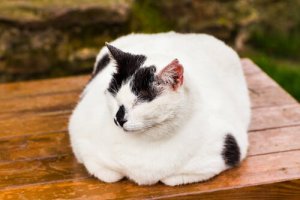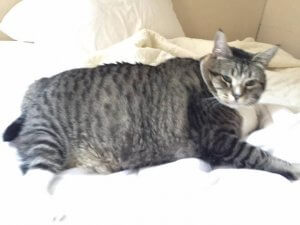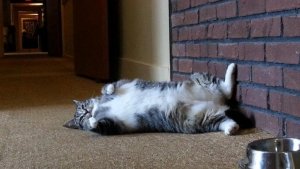How to Treat Obesity in Cats


Written and verified by the lawyer Francisco María García
Being overweight can have irreversible consequences for cats. Therefore, the best way to prevent this is by taking care of their habits.
Cats are naturally agile and active animals, so they’re rarely overweight. When this happens, it’s directly connected with diseases or clinical conditions.
When a cat’s fat exceeds 10% of its weight, it’s considered overweight. Then, when it’s more than 20%, it’s considered obese.
Obesity in cats triggers major diseases like diabetes, as well as joint problems. Therefore, it’s important to control any irregularity in your cat’s weight.

Causes of obesity in cats
In addition to causes, there are conditions that can predispose obesity in cats:
- Age and sex. In fact, adult cats tend to suffer from obesity. This has to do with decreased physical activity and eating more. Also, sex is a trigger for being overweight because males are more prone to obesity. For example, this is more common in neutered cats.
- Breed. Mixed cats are more likely to be overweight. Therefore, the opposite is true for purebred cats. Also, there are breeds that, once they reach adulthood, tend to put on weight. For example, this happens with the beautiful Persian cats.
- Physical activity. Cats who leave and enter their home freely rarely suffer from obesity. In addition, this is also true for cats that live with other animals.
- Lone cats generally aren’t as active, which is a big factor for obesity.
- Poor diet. Some owners use food as a way to show affection to their cat as a way to reward them. However, this can lead to overfeeding.

Owners’ attitude has a lot of influence. In fact, about 60% of obese cats are like that because their owners feed them too much.
How to treat obesity in cats
Here are some recommendations to reduce obesity in cats. However, it’s up to the owner to make it work.
- Create good eating habits. It’s not just about the amount of food, but also the schedule. Cats need to get used to eating at the same time and the same amount of food.
In fact, some specialists recommend only eating cat food. Among other things, you can control the amount of calories they eat.
However, others think that animals should eat natural food. This contains more protein, which benefits cats’ muscular development.
- Limit the amount of food. We don’t recommend for cats to have their food available at any time. It’s best for the owner to give the food at meal times. They can be two controlled meals – morning and afternoon – or small portions throughout the day to keep them active.
- Encourage physical activity. The best prize that an animal can receive is affection and quality time. Therefore, you can replace treats with walks or outdoor games. Climbing and towers are good options that you can have at home. In addition, you give them toys that activate their hunting instinct.
- Learn about cat food. Most commercial foods have their nutrition table controlled. However, not all foods are for all types of cats. Therefore, you need to look at the amount of fat and calories to control them. Make sure you read the nutrition labels before buying.
Prevention
Obesity in cats can trigger more complex or chronic pathologies. In fact, some of these diseases can be diabetes, high blood pressure, and heart failure.
Finally, to prevent obesity in cats, make sure you take them to the vet. The vet can track your cat’s weight and size, making it easy to notice anything irregular.
Being overweight can have irreversible consequences for cats. Therefore, the best way to prevent this is by taking care of their habits.
Cats are naturally agile and active animals, so they’re rarely overweight. When this happens, it’s directly connected with diseases or clinical conditions.
When a cat’s fat exceeds 10% of its weight, it’s considered overweight. Then, when it’s more than 20%, it’s considered obese.
Obesity in cats triggers major diseases like diabetes, as well as joint problems. Therefore, it’s important to control any irregularity in your cat’s weight.

Causes of obesity in cats
In addition to causes, there are conditions that can predispose obesity in cats:
- Age and sex. In fact, adult cats tend to suffer from obesity. This has to do with decreased physical activity and eating more. Also, sex is a trigger for being overweight because males are more prone to obesity. For example, this is more common in neutered cats.
- Breed. Mixed cats are more likely to be overweight. Therefore, the opposite is true for purebred cats. Also, there are breeds that, once they reach adulthood, tend to put on weight. For example, this happens with the beautiful Persian cats.
- Physical activity. Cats who leave and enter their home freely rarely suffer from obesity. In addition, this is also true for cats that live with other animals.
- Lone cats generally aren’t as active, which is a big factor for obesity.
- Poor diet. Some owners use food as a way to show affection to their cat as a way to reward them. However, this can lead to overfeeding.

Owners’ attitude has a lot of influence. In fact, about 60% of obese cats are like that because their owners feed them too much.
How to treat obesity in cats
Here are some recommendations to reduce obesity in cats. However, it’s up to the owner to make it work.
- Create good eating habits. It’s not just about the amount of food, but also the schedule. Cats need to get used to eating at the same time and the same amount of food.
In fact, some specialists recommend only eating cat food. Among other things, you can control the amount of calories they eat.
However, others think that animals should eat natural food. This contains more protein, which benefits cats’ muscular development.
- Limit the amount of food. We don’t recommend for cats to have their food available at any time. It’s best for the owner to give the food at meal times. They can be two controlled meals – morning and afternoon – or small portions throughout the day to keep them active.
- Encourage physical activity. The best prize that an animal can receive is affection and quality time. Therefore, you can replace treats with walks or outdoor games. Climbing and towers are good options that you can have at home. In addition, you give them toys that activate their hunting instinct.
- Learn about cat food. Most commercial foods have their nutrition table controlled. However, not all foods are for all types of cats. Therefore, you need to look at the amount of fat and calories to control them. Make sure you read the nutrition labels before buying.
Prevention
Obesity in cats can trigger more complex or chronic pathologies. In fact, some of these diseases can be diabetes, high blood pressure, and heart failure.
Finally, to prevent obesity in cats, make sure you take them to the vet. The vet can track your cat’s weight and size, making it easy to notice anything irregular.
This text is provided for informational purposes only and does not replace consultation with a professional. If in doubt, consult your specialist.








